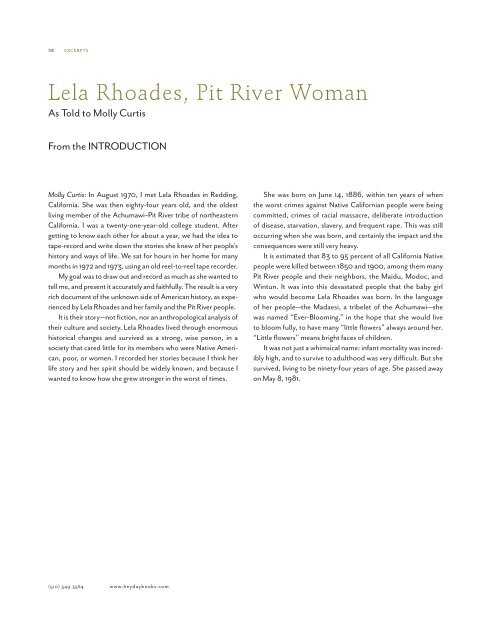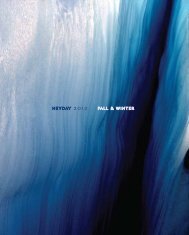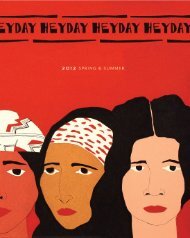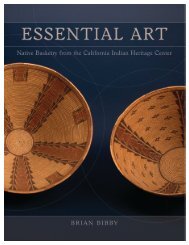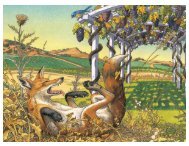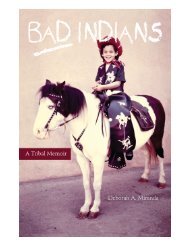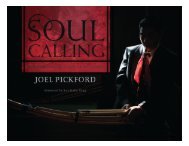You also want an ePaper? Increase the reach of your titles
YUMPU automatically turns print PDFs into web optimized ePapers that Google loves.
38 EXCERPTSLela Rhoades, Pit River WomanAs Told to Molly CurtisFrom the INTRODUCTIONMolly Curtis: In August 1970, I met Lela Rhoades in Redding,California. She was then eighty-four years old, and the oldestliving member of the Achumawi–Pit River tribe of northeasternCalifornia. I was a twenty-one-year-old college student. Aftergetting to know each other for about a year, we had the idea totape-record and write down the stories she knew of her people’shistory and ways of life. We sat for hours in her home for manymonths in 1972 and 1973, using an old reel-to-reel tape recorder.My goal was to draw out and record as much as she wanted totell me, and present it accurately and faithfully. The result is a veryrich document of the unknown side of American history, as experiencedby Lela Rhoades and her family and the Pit River people.It is their story—not fiction, nor an anthropological analysis oftheir culture and society. Lela Rhoades lived through enormoushistorical changes and survived as a strong, wise person, in asociety that cared little for its members who were Native American,poor, or women. I recorded her stories because I think herlife story and her spirit should be widely known, and because Iwanted to know how she grew stronger in the worst of times.She was born on June 14, 1886, within ten years of whenthe worst crimes against Native Californian people were beingcommitted, crimes of racial massacre, deliberate introductionof disease, starvation, slavery, and frequent rape. This was stilloccurring when she was born, and certainly the impact and theconsequences were still very heavy.It is estimated that 83 to 95 percent of all California Nativepeople were killed between 1850 and 1900, among them manyPit River people and their neighbors, the Maidu, Modoc, andWintun. It was into this devastated people that the baby girlwho would become Lela Rhoades was born. In the languageof her people—the Madaesi, a tribelet of the Achumawi—shewas named “Ever-Blooming,” in the hope that she would liveto bloom fully, to have many “little flowers” always around her.“Little flowers” means bright faces of children.It was not just a whimsical name: infant mortality was incrediblyhigh, and to survive to adulthood was very difficult. But shesurvived, living to be ninety-four years of age. She passed awayon May 8, 1981.(510) 549-3564 www.heydaybooks.com
EXCERPTS 39From Chapter One, “THE COMING OF THE FIRST WHITES”Lela Rhoades: I will tell a story about my grandfather, mymother’s father, and about my people. His name was JackNefice. His Pit River name was Jwasdee janay ju. Thatmeans “man from where the young trees grow.” He wasraised in Goose Valley, one of five brothers. They livedthere when they were young children. They hunted andfished. Goose Valley is a good hunting place, and they hadplenty of ducks. That’s how they made their living. Thereused to be a swamp there, and in the summer it wouldalmost dry up, but still be swampy. All their food grewright in that field there, tule plants and all kinds of roots.They lived there until my grandfather married mygrandmother. Her name was Nancy Charles, and she wasfrom where Pit One [a PG&E power plant] is now. She wasreally young when they got married. They lived there untilthey started having trouble with the white people.We had known that strangers were coming, becausea prophet told us. “Coming in a boat,” he said. “Strangepeople. They’re bringing black water, black water andsome food. Don’t eat it.” That was the hog meat. And theblack water—whether it was coffee or whiskey, I’m notsure. Must have been whiskey, because he said, “You’regoing to die. Lots of you are going to die. Don’t eat theirfood. Some of these people will be good, and some willbe bad.” (“Some will be good”—probably that means thecommon people, the Christian people.)“Don’t do things their way, don’t copy them. They’regoing to do a lot of things to kill themselves. Look out foryourselves, do what is right and keep your mind on it all thetime.”This was way before my great-grandfather’s time that theprophet said this. Indian doctors are prophets. I never was toldthis one’s name; his name was forgotten. And the whites arekilling each other with guns and in airplanes and car wrecks.When we traveled afoot we didn’t fall and break a leg or killourselves. We’d just stumble and get a little scratch. And wedidn’t kill much of our own people: Hat Creek people didn’tcome and kill the Goose Valley people; Goose Valley peopledidn’t attack the Pit Rivers. Big Bend, Pit Rivers, Hat Creek,and Maidu were all friendly. Except distant people, strangers,like Shoshone, maybe they weren’t friendly; they might kill youfor something.This Wintun prophet said not to copy the white people,but still the Indian people did copy them…They did…Why?Because they had to, I guess. Everything’s too destroyed, andwe can’t mend it up now. It would be too impossible, even if wedid get a piece of land. Oh, we could raise a little garden, farma little, but that’s about all. We can’t go back and live like wedid years ago. No game now and hardly any fish. You can’t goout and fish—they’ll arrest you. Everything’s all tied up.There was enough land then for everybody, if the whitepeople had acted different. There still is enough land for all ofus. Look at the land they wasted, and is wasted now. Look atthe people who are hoggish. Some people own so much, andwe have nothing now.For book information, see p. 17.(510) 549-3564 www.heydaybooks.com


